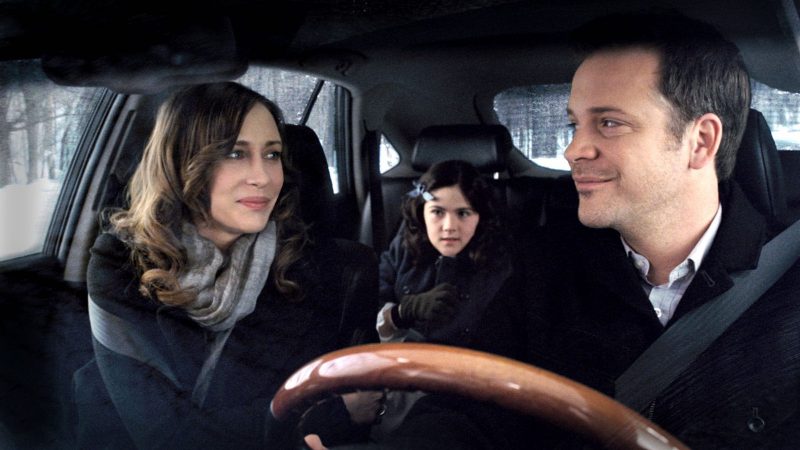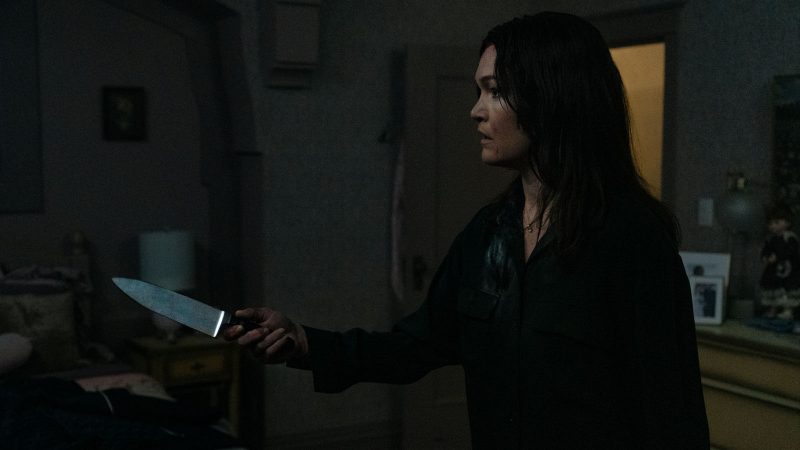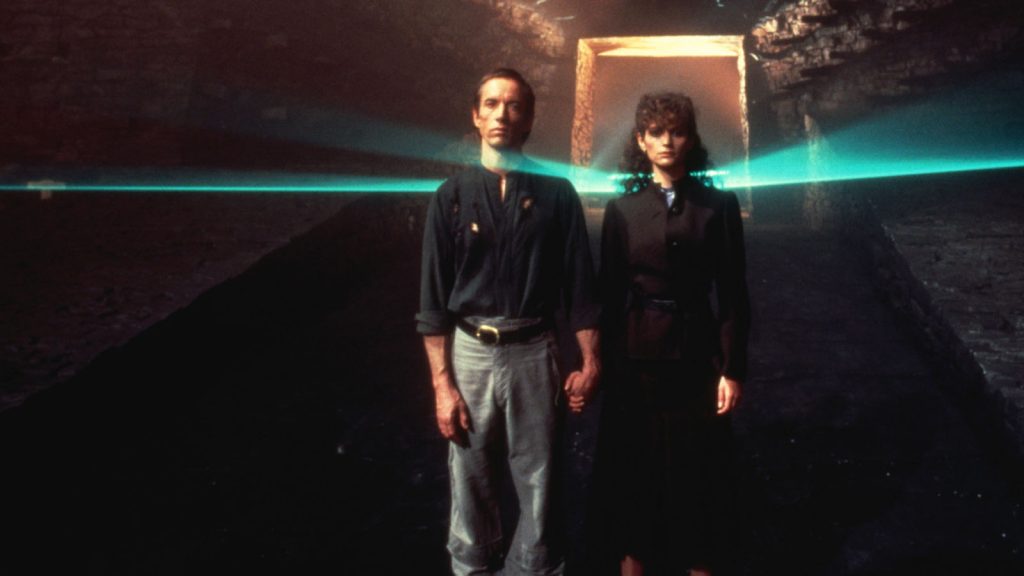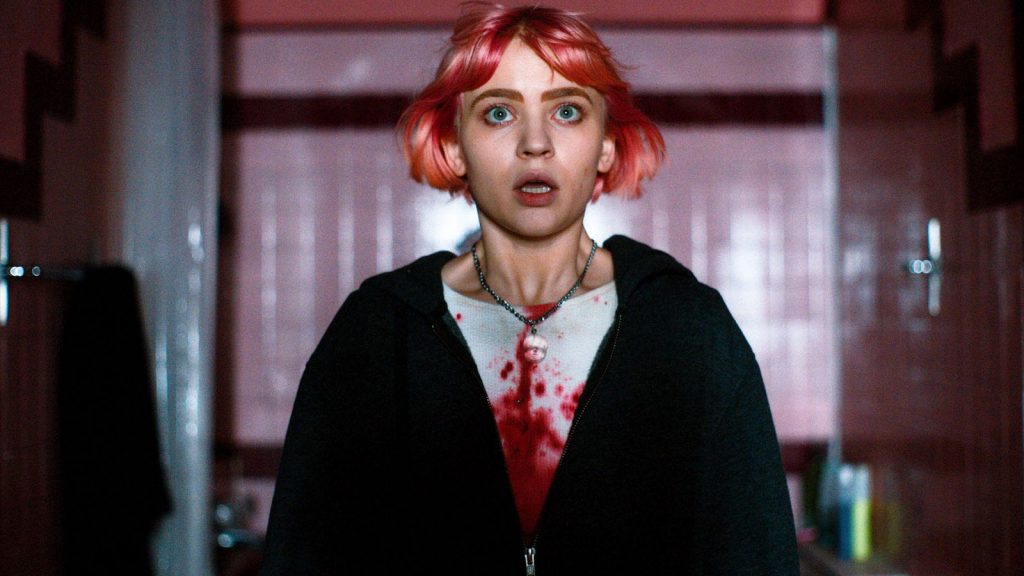A horde of diabolical children have preceded Esther of Orphan (2009), directed by Jaume Collet-Serra, but she has secured a place among horror cinema’s most memorable enfants terribles, even before its long-awaited prequel, Orphan: First Kill, arrived last year. The original film’s prologue, a graphic scene of childbirth, grimly heralds its central principles in a ghostly dream sequence that at once prefigures this tale’s grotesque “girlhood” (the infant is a shrieking, blood-soaked baby girl) and attests to the genre’s enduring preoccupation with ambivalent maternity. The vision belongs to Kate Coleman (Vera Farmiga), formerly a distinguished music professor, now recovering from alcoholism in the wake of her third child’s stillbirth. Curiously, this disorienting echo of a not-uncommon, all-too-knowable horror relies on neither phantasm nor very much perversion. A nurse tells Kate that her baby has died, but Kate still observes deviant, protracted movement in her belly. The subsequent extraction requires—more alarming than anything else—a series of decidedly freakish metal devices, hardly unrealistic within the realm of obstetrics, or, at least, not unusual among the field’s various other medieval fixtures. Throughout this abrupt, clinical, and grisly procedure, Kate is trapped, awake and duly distraught as figures clad in pristine white mill indifferently around her, oblivious to her distress. The “nightmare” of birth, then—or, in other words, the inception of motherhood—is no dream but a waking horror, barely distinguishable from reality.
Kate and her husband, John (Peter Sarsgaard), already have a 12-year-old son, Daniel (Jimmy Bennett), and a 5-year-old deaf daughter, Max (Aryana Engineer). But the loss of the baby has left upon the family certain glaring fissures, ripe for cleaving. In what seems a foolishly impulsive effort to seal these aching gaps, the Colemans decide to add to their brood with the adoption of Esther (Isabelle Fuhrman), a 9-year-old Russian girl, whose last adoptive family perished in a mysterious fire. She strikes a peculiarly antiquated portrait of girlhood, with her collared, fussy dresses, ribbons knotted around her pigtails and wrists, and a lace choker adorns her neck. As it turns out, for all her saccharine smiles and prim manners, bizarre happenings seem to trail Esther. The school bully falls off the playground slide and breaks her leg, while Esther looms nearby. A nun comes to the Coleman house bearing information about Esther’s past and ends up viciously murdered by the roadside. Daniel’s treehouse burns to the ground. Meanwhile, Esther nurses a troubling crush on her new father, curling up beside him in bed and intruding upon John and Kate mid-sex. An increasingly suspicious Kate begins looking for answers, only to discover that her “daughter” is actually Leena, a 33-year-old woman with hypopituitarism, a rare disorder that stunts her physical growth. Far more alarming, she has just escaped a mental hospital where she was notorious among the patients for her especially violent propensities.

Few contemporary horror films have achieved a lofty place on the “high side” of the genre—decorated by Dreyer, Hitchcock, Kubrick, Carpenter, et al.—and even by charitable standards, Orphan harbors more pedestrian ambitions. This, in fact, is its triumph: a story that seeks to thrill above all else. The film arrived a little too early for the respectable generation of horror ushered in by the mid-2010s, when that objective had not yet been supplanted. Upon its release, the film generally garnered warm reviews for its well-crafted tension, originality, and shocking reveal. Indeed, among its peers (some admittedly more memorable than others)—including The Ring (2002), Joshua (2007), The Orphanage (2007), Eden Lake (2008), Case 39 (2009), and Sinister (2012)—Orphan can boast the distinction of its twist: that the corrupted child at the center of its tale is not really a child at all, but an embittered grown woman. An entire lineage of monstrosity collapses, with remarkable richness, in the character of Esther, who embodies a characteristic collision of the foreign and the sexual. Her intrusion upon this all-American family suggests old, conservative anxieties about distant, unfamiliar peoples, but likewise, her sexuality threatens to destabilize their home. On the other hand, her outward juvenile presentation visualizes the domestic peril epitomized by any girl-child, whose mere feminine presence menaces her mother as she ages out of patriarchal usefulness.
Indeed, woman and monster possess a propertied cinematic kinship, in and outside of horror, although nowhere else is this legacy more pronounced than in the mother figure. She may or may not herself wield the knife or ax or hammer, but this is her power: that she need never lift a finger; one can often trace the pile of bodies back to her lack or excess, and she exerts her will as rapaciously in life as she may in death. Of course, Orphan squarely anchors itself in Kate’s perspective, and far from rendering her merely sympathetic, the film pivots on her perceptiveness, in relentless tension with her husband and her therapist, both convinced by Esther’s charade. But the second installment betrays murkier allegiances, more aligned with the slasher’s cadre of devious mothers.

Set two years before the events of its predecessor, Orphan: First Kill (this one directed by William Brent Bell) details Leena’s bloody escape from an Estonian sanitarium and her time with the WASPy Albrights of Darien, Connecticut—the family doomed to meet a fiery fate before she lands with the Colemans. Leena has chosen the Albrights with the plans of impersonating their missing daughter, Esther, which she manages to do, albeit imperfectly: Allen (Rossif Sutherland), an artist, blindly bonds with her, despite her strange accent and her inconsistent account of her absence, but his socialite wife, Tricia (Julia Stiles) and their son, Gunnar (Matthew Finlan), plainly distrust her, even as they disguise their suspicions before Allen. Detective Donnan (Hiro Kanagawa), too, long haunted by the case, regards Esther with thinly veiled incredulity. This time, the dramatic twist arrives halfway through the film, when Esther, in the middle of attacking Donnan, finds an unexpected ally in Tricia, who shoots him dead. Online chatter feverishly embraced Stiles’s weary delivery of the lines: “So let me get this straight: you’re a grown-ass woman, and a wanted criminal? That is beyond fucked-up.” More than 10 years after the release of the first film, the prequel entered a new cinematic landscape and shrewdly—if, on occasion, speciously—leaned into camp and dark humor. But really, the most telling dialogue comes straight after, when Tricia waves her arm over Doonan’s lifeless body, lying before them in a pool of his own blood. “This is all I ever do anymore, by the way. Clean up after my kids,” she sighs. “Mommy takes care of everything.” She admits she had known all along that Leena was an imposter because Esther isn’t really missing: Gunnar killed his sister four years ago, and Tricia covered it up. Kate and Tricia, then, represent two deceptively opposing versions of motherhood: one vulnerable, one steely; one driven mad by the structural forces that ensure women remain unheard amid her to parent effectively while mired in trauma, and the other versed in deception and cynical, calculated silence, thus able to survive through disguise, not unlike Leena herself. In fact, both women may be defined by their—somewhat flawed—devotion to their children, however (in Tricia’s case) misguided.
Horror returns so frequently (if not fundamentally) to the family as a unifying image in part because it operates as a reliable provenance for all manner of dysfunction. Esther infiltrates not-quite-happy homes, already devastatingly fractured before she ever appeared, and—before filial rejection incites her bloody rampages—simply exposes the rusted schisms. If Esther emerges as a villain for the Colemans, she is clearly the protagonist in the film’s nominal prequel. Both films to date revel in the core depravity and misery bred within the nuclear family: stifling gender roles, jealous children, jealous parents, and the threat of incest. Superficially, the series’ duality seems to disparage adoption (a critique levied against the first movie), but upon closer inspection, both films more vigorously object to the patriarchal, bourgeois-capitalist families at their center: the Albrights certainly, but also the oft-distracted Colemans, who persistently fail to keep close enough tabs on their children. This affords Esther much latitude to terrorize them. While Kate is turned away, her car—with Max in the back seat—begins a steady roll down a hill. Daniel’s treehouse is nearly embers before Kate realizes it’s ablaze (although she stands in full view of the window), and by then, her son is horribly injured. But even before Esther came to menace her, Kate carries the unbearable guilt sired from her neglect, when Max almost drowned in an icy lake outside their home when Kate was deep in the throes of her alcoholism.
Motherhood becomes the cornerstone of this franchise-in-the-making, but each matriarch is activated by Esther, the archetypal Daughter—the Mother’s inevitable usurper—and therefore, like any double, a harbinger of death. The films are inspired by the case of then-34-year-old Barbora Skrlová, who disguised herself as a 13-year-old girl and convinced her first adoptive mother to abuse her children, then later impersonated a 13-year-old boy who had gone missing. The Orphan films largely borrow from a sprawling screen heritage of spectral, mad, or demonic children, most visibly The Bad Seed (1956) and The Brood (1979). But Esther’s desires are hardly immature; she does not long for a mother’s love nor is she driven by childish greed that spills over into murder. Her truest ancestor is the girl-vampire Claudia, who, likewise, in Interview with the Vampire (1994), grew older and wiser while her body remained eternally a child’s (as played by a preteen Kirsten Dunst). Esther longs for sexual satisfaction, but she seems to specifically want a husband and father, and invariably ends up driven to violence when these men, who have previously seen her as their daughter, spurn her advances. If Claudia gave literal expression to the social condition of 18th-century womanhood—forever infantilized and enshrined in the domestic—Esther appears even more tragic: destined to remain locked, not just in childhood, but in her own alienation. 🩸

has a PhD in horror cinema and her work has been published in Film Comment, Reverse Shot, and MUBI Notebook, among others.
Bones and All—Luca Guadagnino’s latest monument to ill-fated love, based on the 2016 young-adult novel by Camille DeAngelis...
BY KELLI WESTON | November 23, 2022
Consider Titane a reverse-slasher: not merely because in place of the usual murderous man-child in gender distress, fueled by psychosexual rage to terrorize mainly (or most enthusiastically)...
BY KELLI WESTON | October 31, 2021
Last night I watched myself sleep then I flew away, a young boy named Dalton writes in crayon shortly before his spirit leaves...
BY NICHOLAS RUSSELL | Updated July 11, 2023

This pre-Code offering packs a lot of story into its typically brisk running time, with several plot threads weaving together a (not always successful) tapestry of spooky and criminal doings.
READ MORE >
BY ANN OLSSON | Month 00, 2021

In what could be the fastest-resulting rape revenge movie, a drunken lout brutally forces himself on Ida, the young woman who doesn't return his affections, during a party over Labor Day.
READ MORE >
BY LAURA KERN | Month 00, 2021

Beast is a lot of movies in one package - fractured fairy tale, belated-coming-of-age story, psychological drama, regional horror film - but above all it's a calling card for its leading lady, Jessie Buckley.
READ MORE >
BY LAURA KERN | Month 00, 2021